Rare Earth Element Detection and Quantification in Coal and Rock Mineral Matrices
Abstract
1. Introduction
2. Materials and Methods
3. Principal Component Analysis of Test Samples
4. LIBS Benchtop Experimental Setup
5. Detection and Selection of Characteristic Emission Lines
6. Temporal Evolution of Plasma Emission
7. Calibration Curves & Limits of Detection (LOD)
8. REE Detection in Natural Samples
9. Double Pulse LIBS for Signal Enhancement
10. Measurements with LIBS-Prototype
11. Conclusions
Supplementary Materials
Author Contributions
Funding
Institutional Review Board Statement
Informed Consent Statement
Data Availability Statement
Acknowledgments
Conflicts of Interest
References
- What Are Critical Materials and Critical Minerals? Available online: https://www.energy.gov/cmm/what-are-critical-materials-and-critical-minerals (accessed on 2 August 2024).
- Schulz, K.J.; DeYoung, J.H., Jr.; Seal, R.R., II; Bradley, D. Critical Mineral Resources of the United States—An Introduction. US Geological Survey: Reston, VA, USA, 2017. [Google Scholar]
- Schulz, K.J.; DeYoung, J.H., Jr.; Seal, R.R., II; Bradley, D. Critical Mineral Resources of the United States: Economic and Environmental Geology and Prospects for Future Supply. US Geological Survey: Reston, VA, USA, 2017. [Google Scholar]
- Suli, L.M.; Ibrahim, W.H.W.; Aziz, B.A.; Deraman, M.R.; Ismail, N.A. A review of rare earth mineral processing technology. Chem. Eng. Res. Bull. 2017, 19, 20–35. [Google Scholar] [CrossRef]
- Lucas, J.; Lucas, P.; Le Mercier, T.; Rollat, A.; Davenport, W.G. Rare Earths: Science, Technology, Production and Use; Elsevier: Amsterdam, The Netherlands, 2014. [Google Scholar]
- Omodara, L.; Pitkäaho, S.; Turpeinen, E.M.; Saavalainen, P.; Oravisjärvi, K.; Keiski, R.L. Recycling and substitution of light rare earth elements, cerium, lanthanum, neodymium, and praseodymium from end-of-life applications—A review. J. Clean. Prod. 2019, 236, 117573. [Google Scholar] [CrossRef]
- Reddy, R.R. Prospective Potential Applications and Emerging Tendencies in Rare Earth Materials. In Rare Earth: A Tribute to the Late Mr. Rare Earth, Professor Karl Gschneidner; Materials. In Rare Earth: A Tribute to the Late Mr. Rare Earth, Professor Karl Gschneidner; Materials Research Forum: Millersville, PA, USA, 2024. [Google Scholar]
- Balaram, V. Sources and Applications of Rare Earth Elements. In Environmental Technologies to Treat Rare Earth Elements Pollution: Principles and Engineering; IWA Publishing: London, UK, 2022. [Google Scholar]
- Bhatt, C.R.; Jain, J.C.; Goueguel, C.L.; Mclntyre, D.L. Determination of rare earth elements in geological samples using laser-induced breakdown spectroscopy (LIBS). Appl. Spectrosc. 2018, 72, 114–121. [Google Scholar] [CrossRef]
- Van Gosen, B.S.; Verplanck, P.L.; Long, K.R.; Gambogo, J.; Seal, R.R., II. The Rare-Earth Elements: Vital to Modern Technologies and Lifestyles. In Fact Sheet; USGS Mineral Resources Program: Reston, VA, USA, 2014; p. 4. [Google Scholar]
- USGS. Rare Earths Statistics and Information. Available online: https://www.usgs.gov/centers/national-minerals-information-center/rare-earths-statistics-and-information (accessed on 15 May 2025).
- Alonso, E.; Sherman, A.M.; Wallington, T.J.; Everson, M.P.; Field, F.R.; Roth, R.; Kirchain, R.E. Evaluating rare earth element availability: A case with revolutionary demand from clean technologies. Environ. Sci. Technol. 2012, 46, 3406–3414. [Google Scholar] [CrossRef]
- Dutta, T.; Kim, K.H.; Uchimiya, M.; Kwon, E.E.; Jeon, B.H.; Deep, A.; Yun, S.T. Global demand for rare earth resources and strategies for green mining. Environ. Res. 2016, 150, 182–190. [Google Scholar] [CrossRef]
- Yadav, J.; Sarker, S.K.; Bruckard, W.; Jegatheesan, V.; Haque, N.; Singh, N.; Pramanik, B.K. Greening the Supply Chain: Sustainable Approaches for Rare Earth Element Recovery from Neodymium Iron Boron Magnet Waste. J. Environ. Chem. Eng. 2024, 12, 113169. [Google Scholar] [CrossRef]
- Verma, S.P.; Santoyo, E.; Velasco-Tapia, F. Statistical evaluation of analytical methods for the determination of rare-earth elements in geological materials and implications for detection limits. Int. Geol. Rev. 2002, 44, 287–335. [Google Scholar] [CrossRef]
- Hall, G.E.; Vaive, J.E.; McConnell, J.W. Development and application of a sensitive and rapid analytical method to determine the rare-earth elements in surface waters. Chem. Geol. 1995, 120, 91–109. [Google Scholar] [CrossRef]
- Golloch, A. Handbook of Rare Earth Elements: Analytics; Walter de Gruyter GmbH & Co KG: Berlin, Germany, 2022. [Google Scholar]
- Zawisza, B.; Pytlakowska, K.; Feist, B.; Polowniak, M.; Kita, A.; Sitko, R. Determination of rare earth elements by spectroscopic techniques: A review. J. Anal. At. Spectrom. 2011, 26, 2373–2390. [Google Scholar] [CrossRef]
- Whitty-Léveillé, L.; Turgeon, K.; Bazin, C.; Larivière, D. A comparative study of sample dissolution techniques and plasma-based instruments for the precise and accurate quantification of REEs in mineral matrices. Anal. Chim. Acta 2017, 961, 33–41. [Google Scholar] [CrossRef]
- Zhiwei, D.E.N.G.; Sutong, G.U.O.; Zhishuai, X.U.; Ziyi, Z.H.A.O.; Ying, L.U.; Li, L.I.U.; Zhongqi, H.A.O. Quantitative Analysis of Rare Earth Elements Based on Double-pulse LIBS Combined with Partial Least Squares Regression. Chin. J. Inorg. Anal. Chem./Zhongguo Wuji Fenxi Huaxue 2024, 14, 183. [Google Scholar]
- Zhou, J.; Hu, S.; Ren, X.; Li, M.; Xu, Y.; Zhang, T.; Tang, H.; Li, H. Rapid quantitative analysis of multiple rare earth elements in NdFeB alloys based on laser-induced breakdown spectroscopy (LIBS) and random forest (RF). Spectrochim. Acta Part B At. Spectrosc. 2024, 217, 106957. [Google Scholar] [CrossRef]
- Fayyaz, A.; Asghar, H.; Alshehri, A.M.; Alrebdi, T.A. LIBS assisted PCA analysis of multiple rare-earth elements (La, Ce, Nd, Sm, and Yb) in phosphorite deposits. Heliyon 2023, 9, e13957. [Google Scholar] [CrossRef] [PubMed]
- Rethfeldt, N.; Brinkmann, P.; Riebe, D.; Beitz, T.; Köllner, N.; Altenberger, U.; Löhmannsröben, H.G. Detection of rare earth elements in minerals and soils by laser-induced breakdown spectroscopy (LIBS) using interval PLS. Minerals 2021, 11, 1379. [Google Scholar] [CrossRef]
- Harmon, R.S.; De Lucia, F.C.; Miziolek, A.W.; McNesby, K.L.; Walters, R.A.; French, P.D. Laser-induced breakdown spectroscopy (LIBS)–an emerging field-portable sensor technology for real-time, in-situ geochemical and environmental analysis. Geochem. Explor. Environ. Anal. 2005, 5, 21–28. [Google Scholar] [CrossRef]
- Yamazaki, A.; Orikasa, Y.; Chen, K.; Uchimoto, Y.; Kamiya, T.; Koka, M.; Satoh, T.; Mima, K.; Kato, Y.; Fujita, K. In-Situ measurement of the Lithium Distribution in Li-Ion Batteries Using Micro-IBA Techniques. In Nuclear Instruments and Methods in Physics Research Section B: Beam Interactions with Materials and Atoms; Elsevier: Amsterdam, The Netherlands, 2016. [Google Scholar]
- Samek, O.; Beddows, D.C.; Kaiser, J.; Kukhlevsky, S.V.; Liska, M.; Telle, H.H.; Whitehouse, A.J. Application of laser-induced breakdown spectroscopy to in situ analysis of liquid samples. Opt. Eng. 2000, 39, 2248–2262. [Google Scholar] [CrossRef]
- Theriault, G.A.; Bodensteiner, S.; Lieberman, S.H. A real-time fiber-optic LIBS probe for the in situ delineation of metals in soils. Field Anal. Chem. Technol. 1998, 2, 117–125. [Google Scholar] [CrossRef]
- Fabre, C.; Ourti, N.E.; Ballouard, C.; Mercadier, J.; Cauzid, J. Handheld LIBS analysis for in situ quantification of Li and detection of the trace elements (Be, Rb and Cs). J. Geochem. Explor. 2022, 236, 106979. [Google Scholar] [CrossRef]
- Martin, M.Z.; Labbé, N.; André, N.; Harris, R.; Ebinger, M.; Wullschleger, S.D.; Vass, A.A. High resolution applications of laser-induced breakdown spectroscopy for environmental and forensic applications. Spectrochim. Acta Part B At. Spectrosc. 2007, 62, 1426–1432. [Google Scholar] [CrossRef]
- Gaft, M.; Nagli, L.; Gorychev, A.; Raichlin, Y. Rare-earth elements detection using diatomic molecular laser-induced plasma spectroscopy. Spectrochim. Acta Part B At. Spectrosc. 2022, 192, 106426. [Google Scholar] [CrossRef]
- Gaustad, G.; Williams, E.; Leader, A. Rare earth metals from secondary sources: Review of potential supply from waste and byproducts. Resour. Conserv. Recycl. 2021, 167, 105213. [Google Scholar] [CrossRef]
- Van Gosen, B.S.; Verplanck, P.L.; Seal, R.R., II; Long, K.R.; Gambogi, J. Rare-Earth Elements; US Geological Survey: Reston, VA, USA, 2017. [Google Scholar]
- Liu, S.L.; Fan, H.R.; Liu, X.; Meng, J.; Butcher, A.R.; Yann, L.; Yang, K.F.; Li, X.C. Global rare earth elements projects: New developments and supply chains. Ore Geol. Rev. 2023, 157, 105428. [Google Scholar] [CrossRef]
- Goodenough, K.M.; Wall, F.; Merriman, D. The rare earth elements: Demand, global resources, and challenges for resourcing future generations. Nat. Resour. Res. 2018, 27, 201–216. [Google Scholar] [CrossRef]
- Bhatt, C.R.; Yueh, F.Y.; Singh, J.P. Univariate and multivariate analyses of rare earth elements by laser-induced breakdown spectroscopy. Appl. Opt. 2017, 56, 2280–2287. [Google Scholar] [CrossRef]
- Hartzler, D.A.; Bhatt, C.R.; Jain, J.C.; McIntyre, D.L. Evaluating laser-induced breakdown spectroscopy sensor technology for rapid source characterization of rare earth elements. J. Energy Resour. Technol. 2019, 141, 070704. [Google Scholar] [CrossRef]
- Bhatt, C.R.; Jain, J.C.; Goueguel, C.L.; McIntyre, D.L.; Singh, J.P. Measurement of Eu and Yb in aqueous solutions by underwater laser induced breakdown spectroscopy. Spectrochim. Acta Part B At. Spectrosc. 2017, 137, 8–12. [Google Scholar] [CrossRef]
- Bhatt, C.R.; Jain, J.C.; Bol’shakov, A.A.; McIntyre, D.L. Chemistry imaging and distribution analysis of rare earth elements in coal using LIBS and LA-ICP-MS instruments. Int. J. Coal Geol. 2025, 301, 104710. [Google Scholar] [CrossRef]
- Martin, M.; Martin, R.C.; Allman, S.; Brice, D.; Wymore, A.; Andre, N. Quantification of rare earth elements using laser-induced breakdown spectroscopy. Spectrochim. Acta Part B At. Spectrosc. 2015, 114, 65–73. [Google Scholar] [CrossRef]
- Edahbi, M.; Plante, B.; Benzaazoua, M.; Kormos, L.; Pelletier, M. Rare earth elements (La, Ce, Pr, Nd, and Sm) from a carbonatite deposit: Mineralogical characterization and geochemical behavior. Minerals 2018, 8, 55. [Google Scholar] [CrossRef]
- NIST Atomic Spectra Database. Available online: https://www.nist.gov/pml/atomic-spectra-database (accessed on 15 May 2025).
- Unnikrishnan, V.K.; Nayak, R.; Devangad, P.; Tamboli, M.M.; Santhosh, C.; Kumar, G.A.; Sardar, D.K. Calibration based laser-induced breakdown spectroscopy (LIBS) for quantitative analysis of doped rare earth elements in phosphors. Mater. Lett. 2013, 107, 322–324. [Google Scholar] [CrossRef]
- Wang, D.; Zhang, A.; Zeng, J.; Wang, X. Quantitative analysis of rare earth elements in lanthanum and cerium carbonate by LIBS metho. EMU 2024, 120, 65. [Google Scholar]
- Ahmed, R.; Baig, M.A. A comparative study of single and double pulse laser induced breakdown spectroscopy. J. Appl. Phys. 2009, 106, 033307. [Google Scholar] [CrossRef]
- Bhatt, C.R.; Hartzler, D.; Jain, J.C.; McIntyre, D.L. Evaluation of analytical performance of double pulse laser-induced breakdown spectroscopy for the detection of rare earth elements. Opt. Laser Technol. 2020, 126, 106110. [Google Scholar] [CrossRef]
- Stratis, D.N.; Eland, K.L.; Angel, S.M. Dual-pulse LIBS using a pre-ablation spark for enhanced ablation and emission. Appl. Spectrosc. 2000, 54, 1270–1274. [Google Scholar] [CrossRef]
- Babushok, V.I.; DeLucia, F.C., Jr.; Gottfried, J.L.; Munson, C.A.; Miziolek, A.W. Double pulse laser ablation and plasma: Laser induced breakdown spectroscopy signal enhancement. Spectrochim. Acta Part B At. Spectrosc. 2006, 61, 999–1014. [Google Scholar] [CrossRef]
- Scaffidi, J.; Angel, S.M.; Cremers, D.A. Emission Enhancement Mechanisms in Dual-Pulse LIBS. ACS Publications: Washington, DC, USA, 2006. [Google Scholar]
- Nicolodelli, G.; Senesi, G.S.; Romano, R.A.; de Oliveira Perazzoli, I.L.; Milori, D.M.B.P. Signal enhancement in collinear double-pulse laser-induced breakdown spectroscopy applied to different soils. Spectrochim. Acta Part B At. Spectrosc. 2015, 111, 23–29. [Google Scholar] [CrossRef]
- Hartzler, D.A.; Jain, J.C.; McIntyre, D.L. Development of a subsurface LIBS sensor for in situ groundwater quality monitoring with applications in CO2 leak sensing in carbon sequestration. Sci. Rep. 2019, 9, 4430. [Google Scholar] [CrossRef]
- Hartzler, D.A.; Bhatt, C.R.; McIntyre, D.L. Design, construction, and validation of an in-situ groundwater trace element analyzer with applications in carbon storage. Sci. Rep. 2023, 13, 7516. [Google Scholar] [CrossRef]
- Hartzler, D.A.; Bhatt, C.R.; McIntyre, D. All Optical Subsurface Elemental Analysis Probe; National Energy Technology Laboratory (NETL): Pittsburgh, PA, USA; Morgantown, WV, USA; Albany, OR, USA, 2022. [Google Scholar]
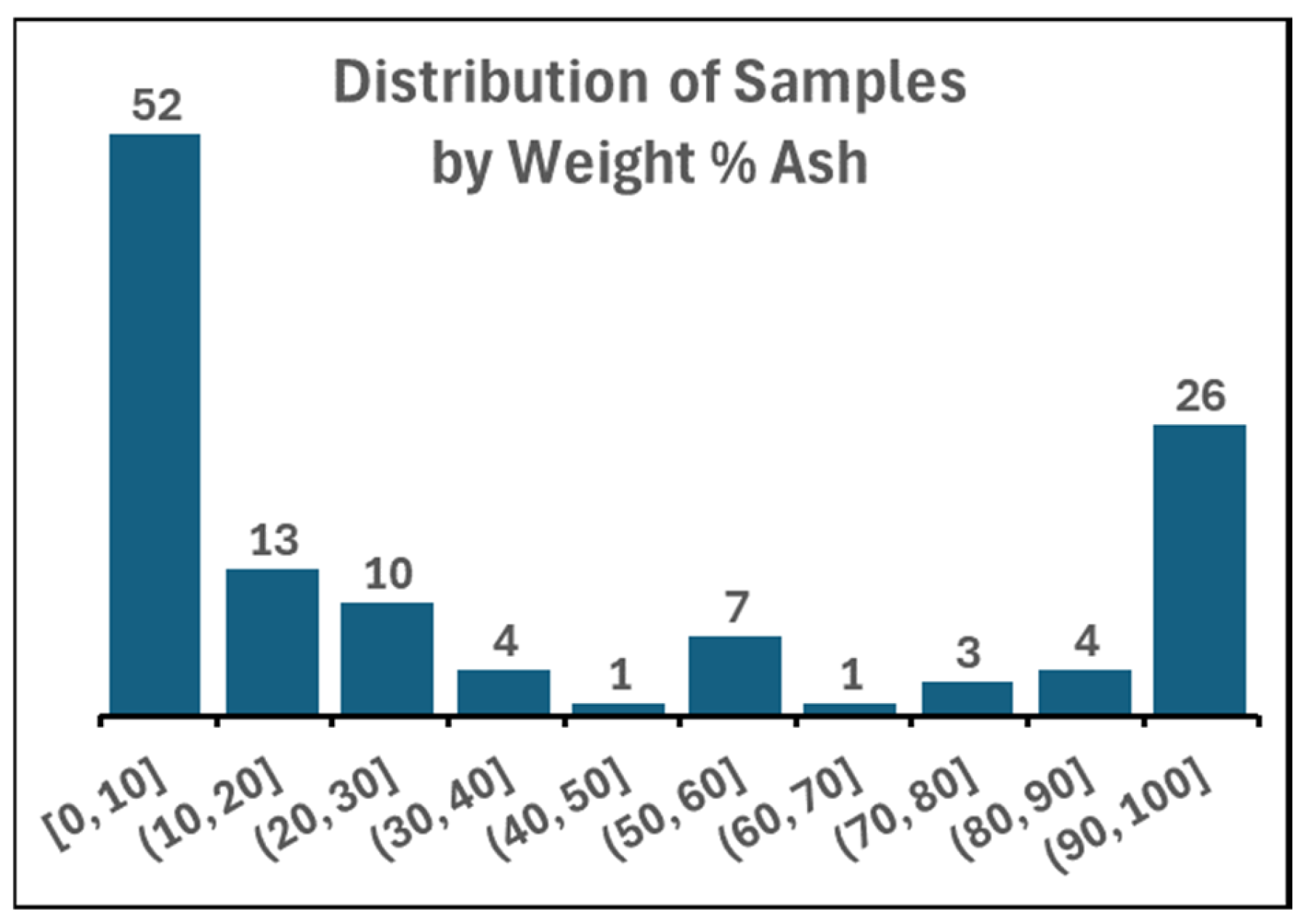
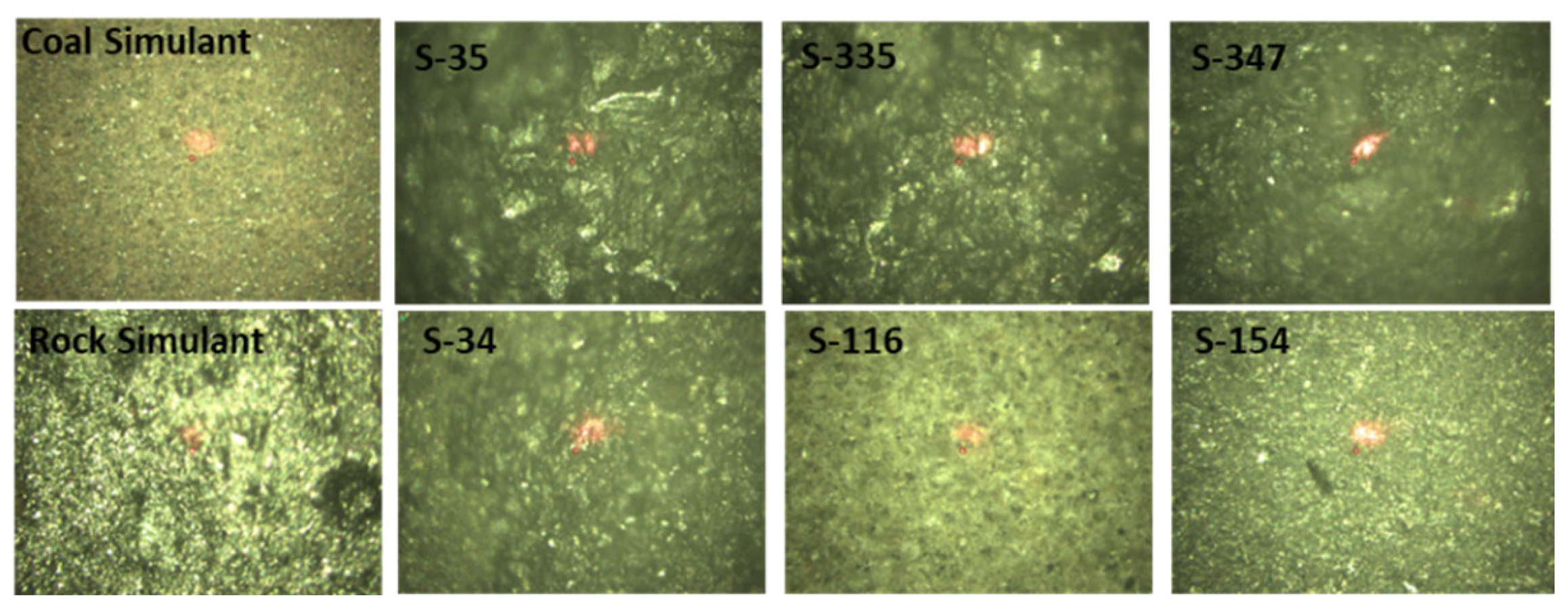
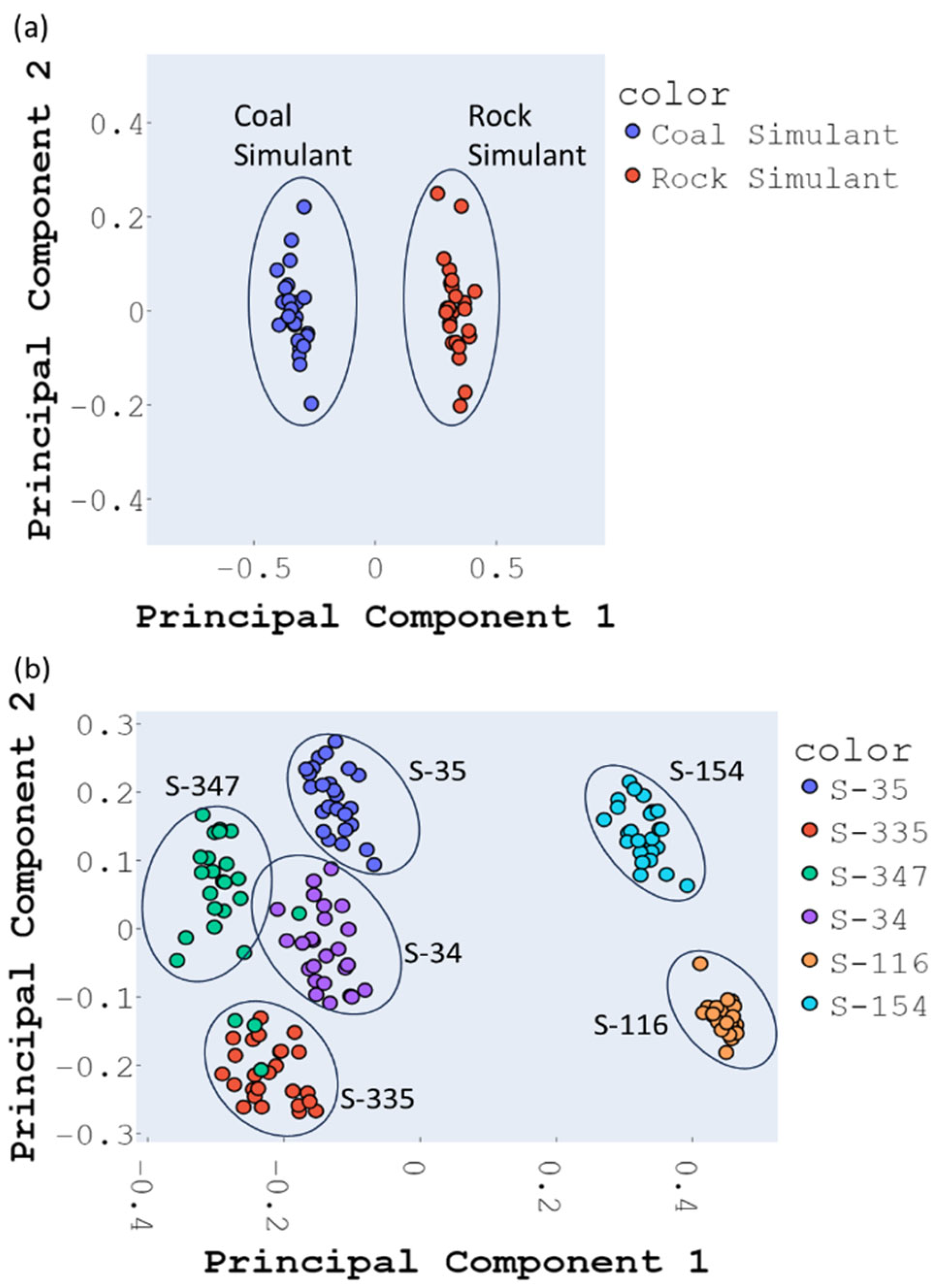
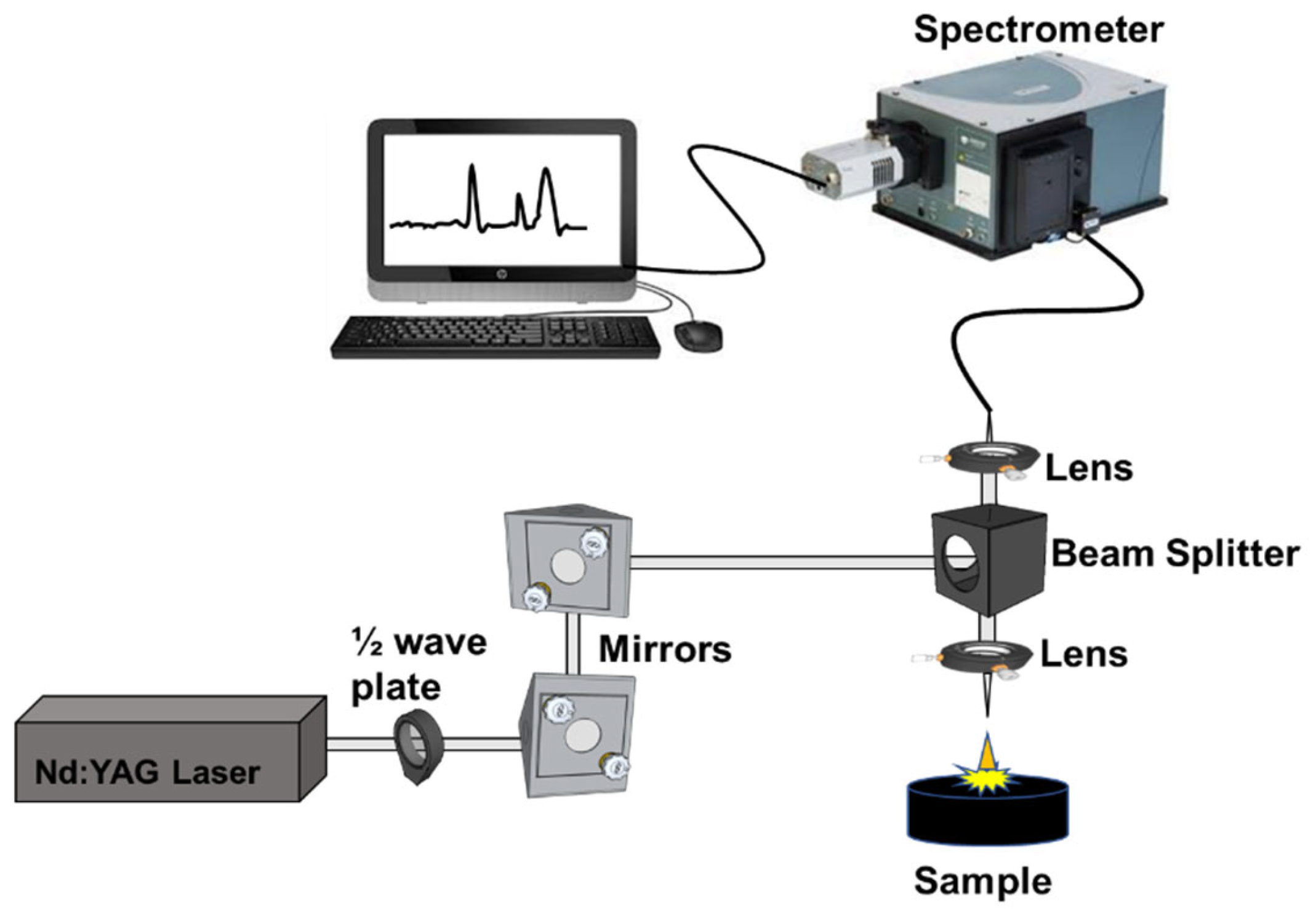
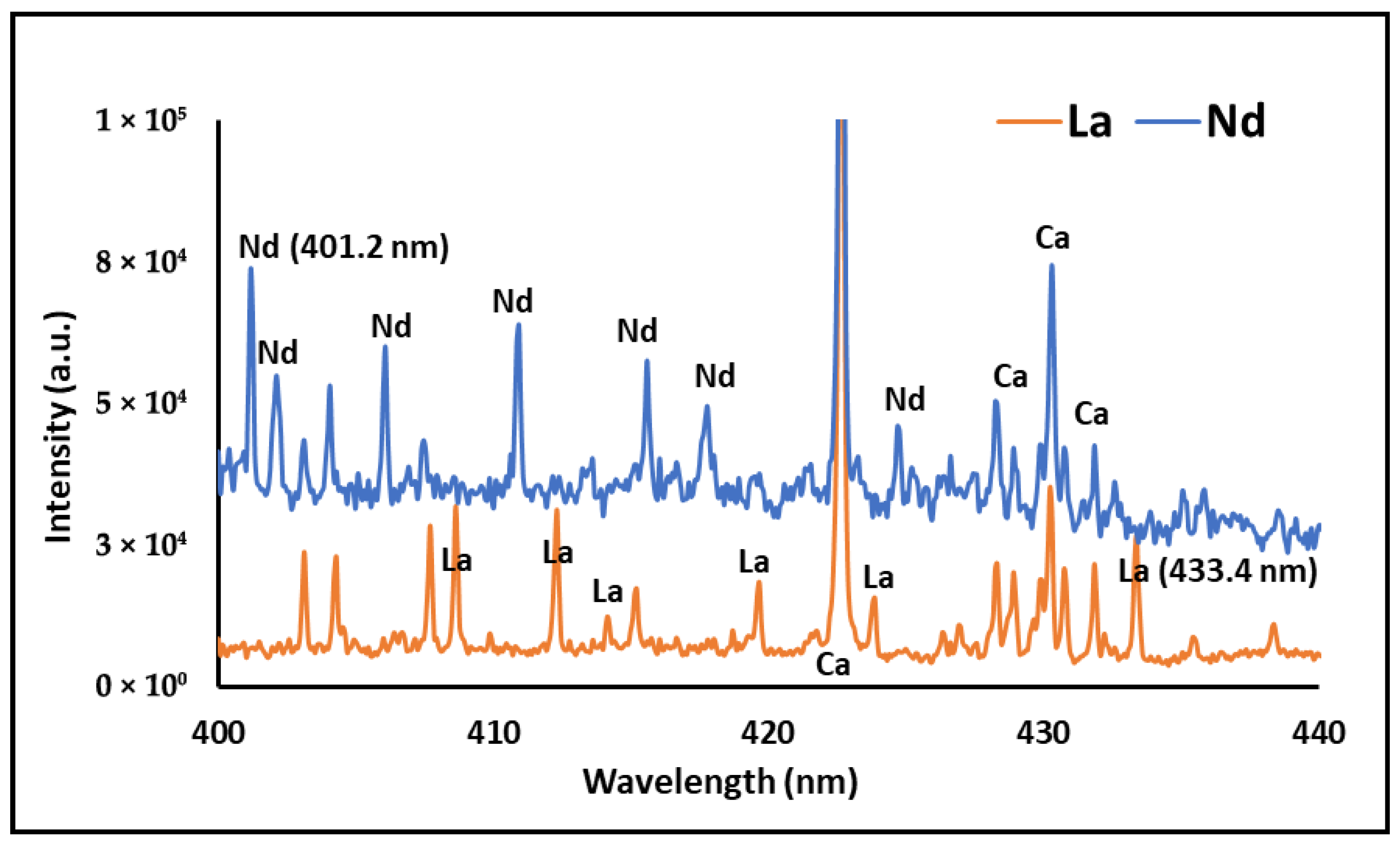
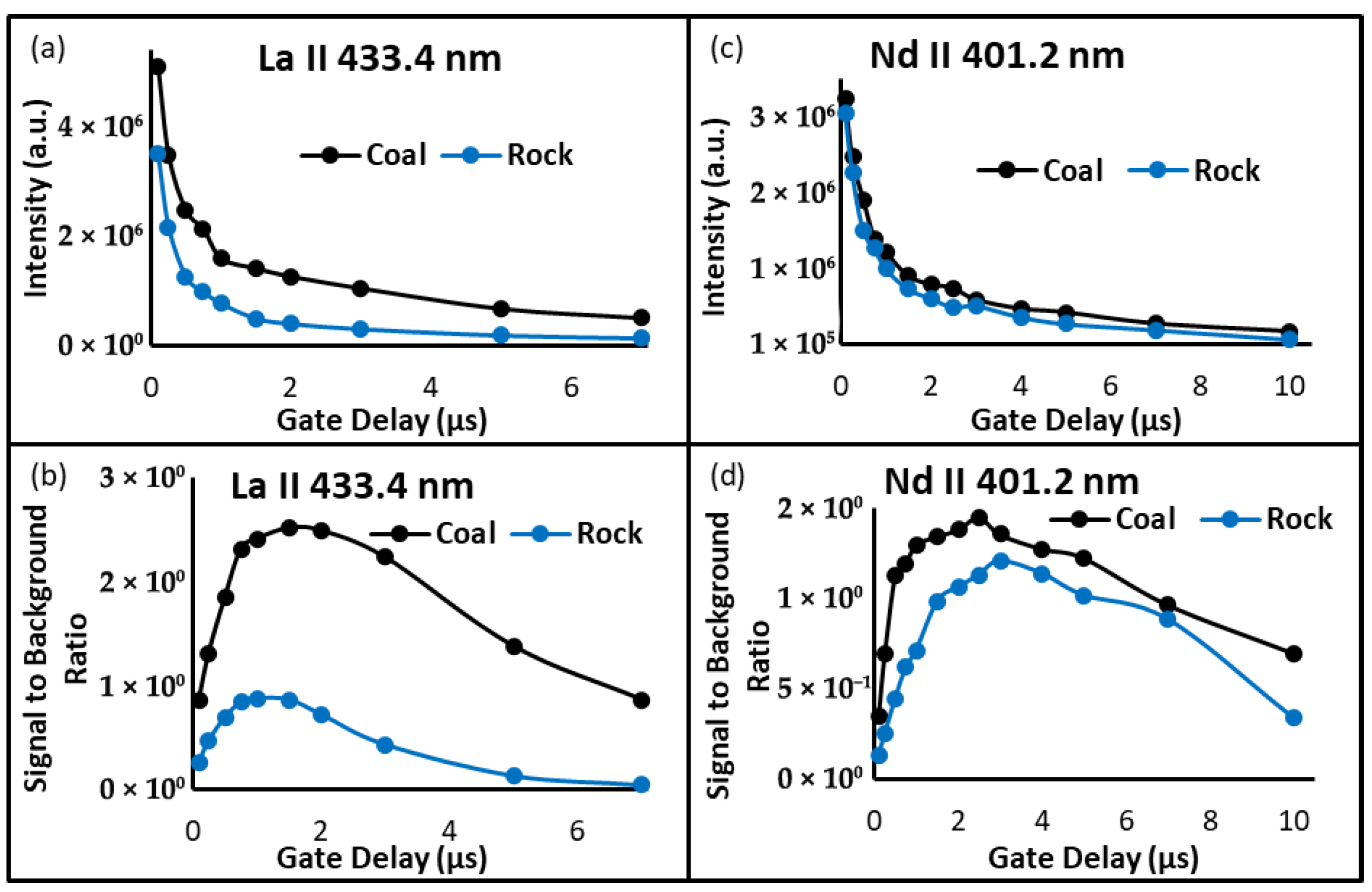
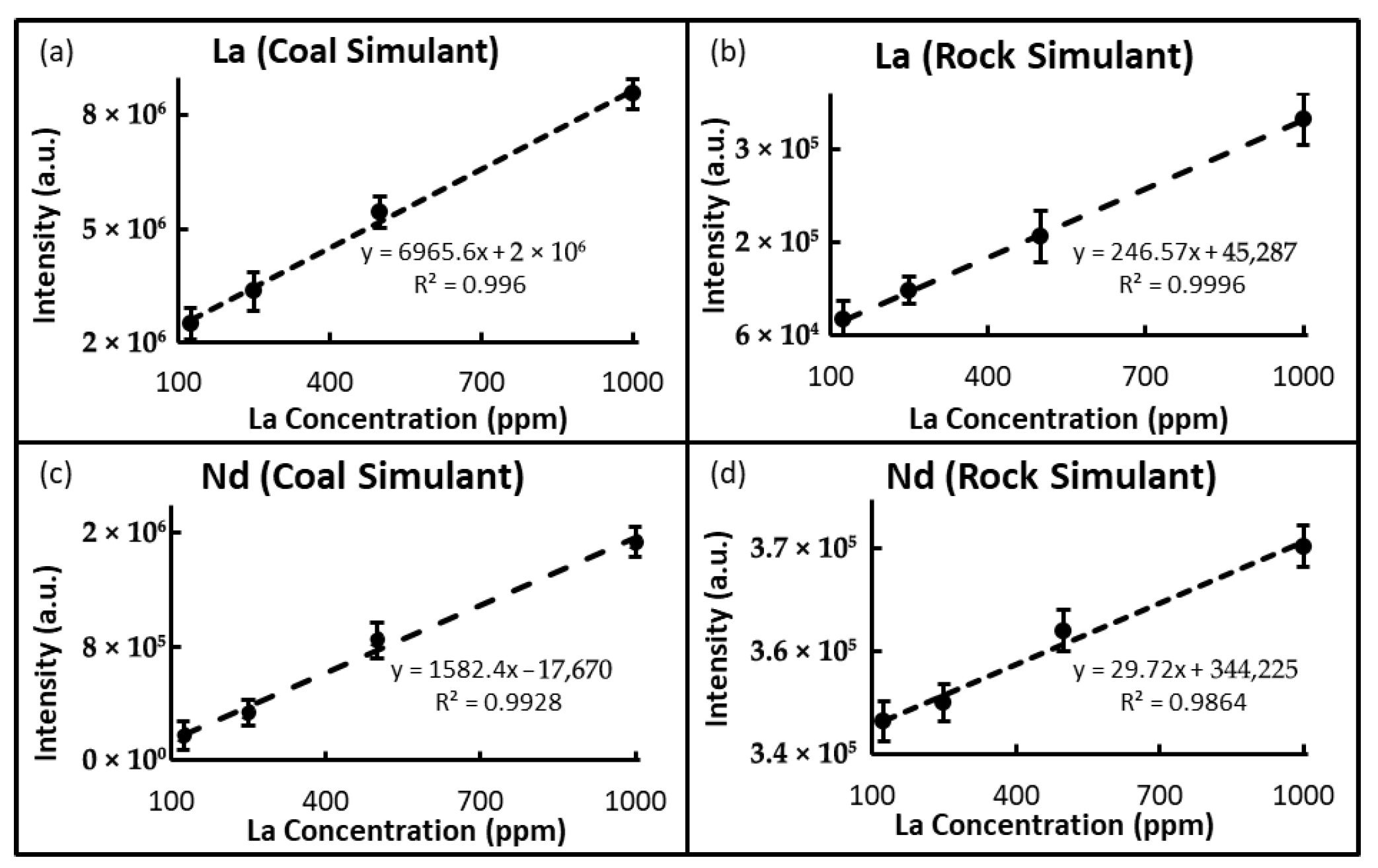
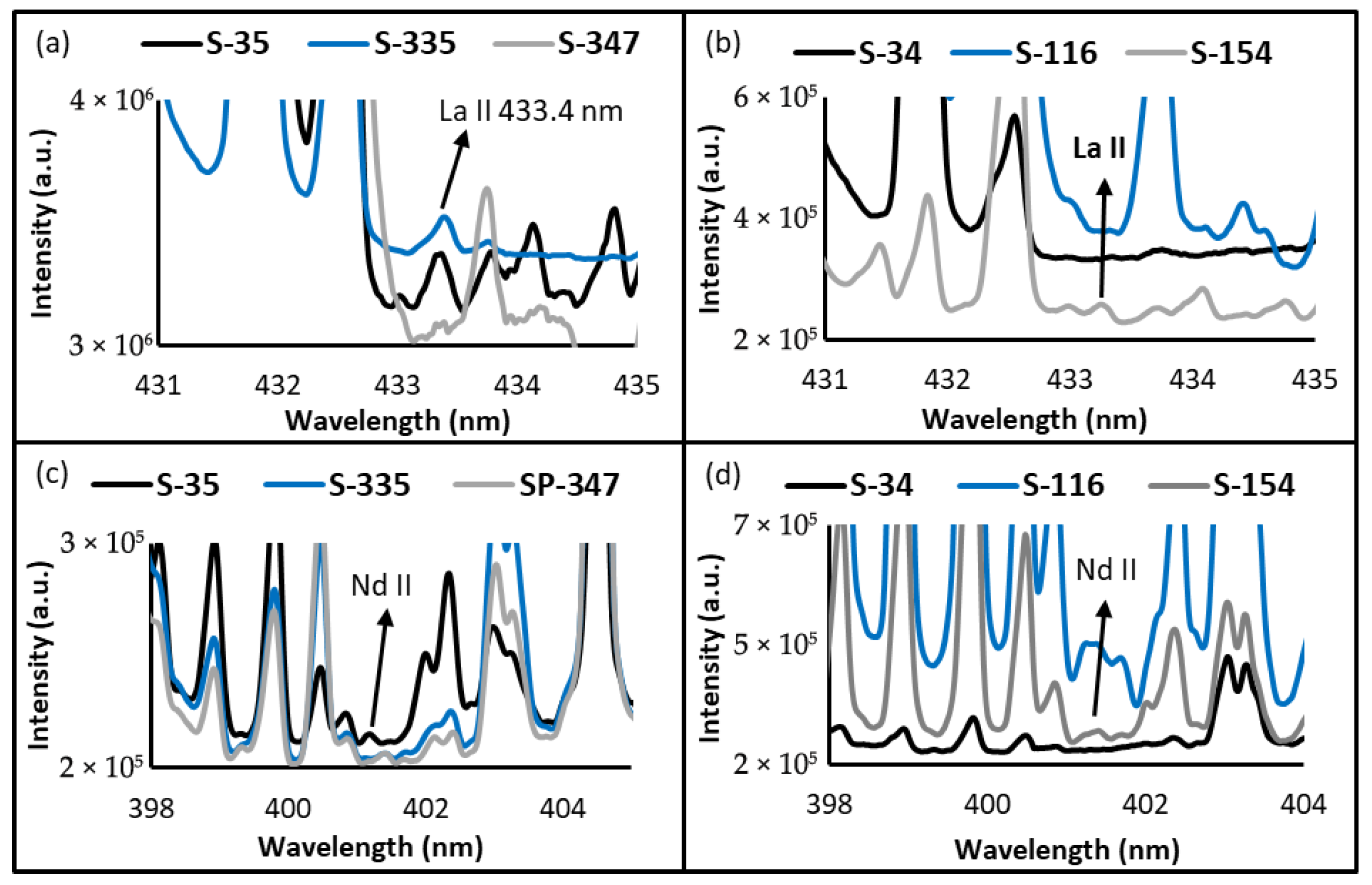
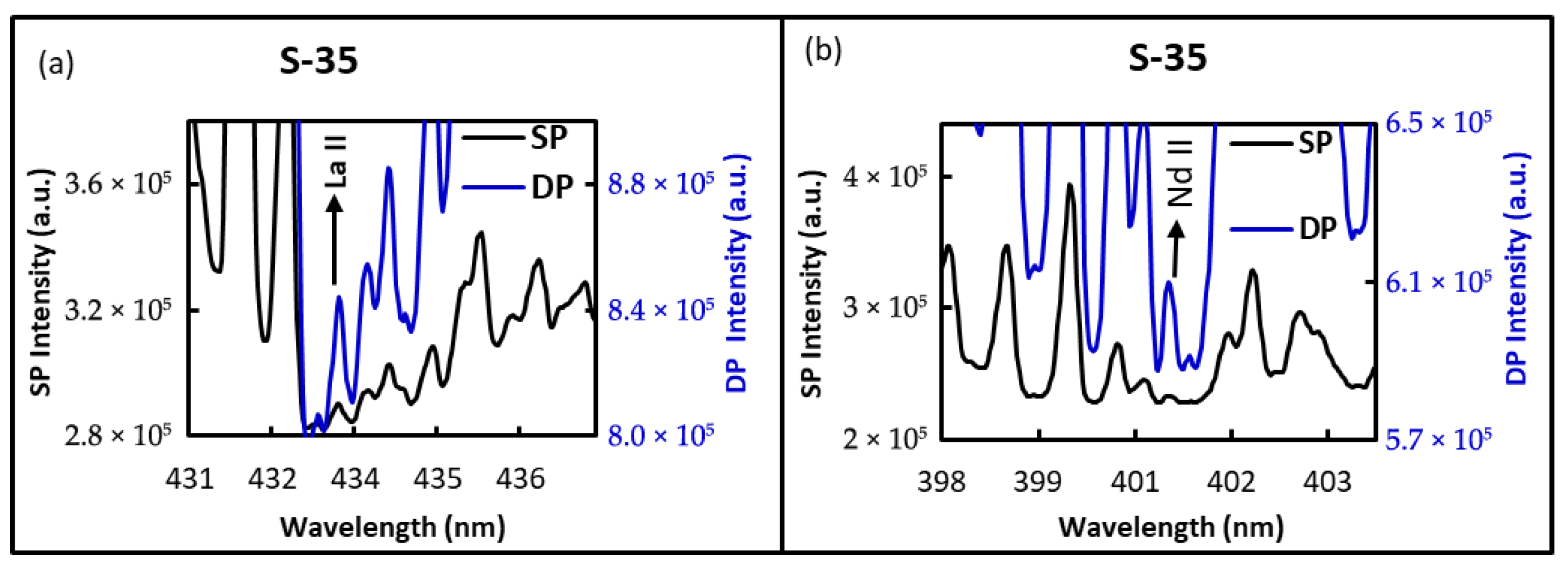


| Sample | ||||||
|---|---|---|---|---|---|---|
| Name | S-347 | S-335 | S-34 | S-35 | S-116 | S-154 |
| Type | Coal | Coal | Coal | Coal | Rock | Mixed |
| Matrix Composition (ppm) | ||||||
| Al † | 54,840 | 43,690 | 107,100 | 125,900 | 101,100 | 148,500 |
| Na | 12,473 | 12,358 | 33,815 | 30,903 | 1081 | 4959 |
| Mg | 22,789 | 32,756 | 60,397 | 46,090 | 7951 | 13,064 |
| Si | 6972 | 44,595 | 90,935 | 129,393 | 326,740 | 274,680 |
| K | 1243 | 1709 | 3661 | 6332 | 20,344 | 15,203 |
| Ca | 206,800 | 263,307 | 146,943 | 101,674 | 3501 | 6669 |
| Ti | 1315 | 2472 | 2454 | 3458 | 5083 | 4939 |
| Fe | 69,950 | 63,177 | 29,709 | 25,058 | 32,341 | 36,275 |
| TGA (wt.%) | ||||||
| Moisture | 32.88 | 17.35 | 16.19 | 19.78 | 1.90 | 13.79 |
| Dry Ash | 5.44 | 6.46 | 5.45 | 6.72 | 92.50 | 37.28 |
| Combust. ‡ | 61.68 | 76.19 | 78.36 | 73.50 | 5.60 | 48.93 |
| Mineral Phase REE Composition (ppm) | ||||||
| Total Rare Earths | ||||||
| REE + Sc + Y | 1080 | 1980 | 1440 | 2500 | 310 | 950 |
| Selected Rare Earths | ||||||
| La | 220 | 490 | 130 | 290 | 52 | 110 |
| Nd | 180 | 250 | 230 | 370 | 50 | 150 |
| Natural Mineral Phase | Mineral Phase Simulant | |||
|---|---|---|---|---|
| Coal | Rock | Coal | Rock | |
| Matrix Element (ppm) | ||||
| Al | 75,270 | 111,593 | 74,300 | 100,000 |
| Na | 18,289 | 1600 | 29,600 | 2620 |
| Mg | 42,540 | 8569 | 38,900 | 8000 |
| Si | 74,367 | 344,342 | 81,400 | 320,000 |
| K | 2516 | 20,983 | 2480 | 20,000 |
| Ca | 186,483 | 5380 | 101,000 | 2870 |
| Ti | 2840 | 4969 | 3010 | 4600 |
| Fe | 50,195 | 23,832 | 49,500 | 22,000 |
| Dry Matter (wt.%) | ||||
| Ash † | 7% | 96% | -- | -- |
| Combust. ‡ | 93% | 4% | -- | -- |
| Coal Mineral Phase (wt.%) | Rock Mineral Phase (wt.%) | |
|---|---|---|
| Mineral Phase Simulant Component | ||
| Al2O3 | 14.03 | 18.90 |
| NaCl | 5.58 | 0.49 |
| MgCO3 | 13.50 | 2.78 |
| SiO2 | 17.40 | 68.48 |
| KCl | 0.47 | 3.81 |
| CaCl2·2H2O | 41.43 | 1.62 |
| TiO2 | 0.50 | 0.77 |
| Fe2O3 | 7.08 | 3.15 |
| Dry Matter | ||
| Mineral phase simulant | 6 | 93 |
| Graphite | 94 | 7 |
| Matrix Element | Coal Simulant (ppm) | Rock Simulant (ppm) |
|---|---|---|
| Al | 4460 | 93,000 |
| Na | 1780 | 2430 |
| Mg | 2330 | 7440 |
| Si | 4880 | 298,000 |
| K | 149 | 18,600 |
| Ca | 6090 | 2670 |
| Ti | 180 | 4280 |
| Fe | 2970 | 20,500 |
| C | 941,000 † | 73,700 ‡ |
| Analyte | Matrix | |
|---|---|---|
| Coal Simulant | Rock Simulant | |
| La | 10 ppm | 14 ppm |
| Nd | 15 ppm | 25 ppm |
Disclaimer/Publisher’s Note: The statements, opinions and data contained in all publications are solely those of the individual author(s) and contributor(s) and not of MDPI and/or the editor(s). MDPI and/or the editor(s) disclaim responsibility for any injury to people or property resulting from any ideas, methods, instructions or products referred to in the content. |
© 2025 by the authors. Licensee MDPI, Basel, Switzerland. This article is an open access article distributed under the terms and conditions of the Creative Commons Attribution (CC BY) license (https://creativecommons.org/licenses/by/4.0/).
Share and Cite
Bhatt, C.R.; Hartzler, D.A.; McIntyre, D.L. Rare Earth Element Detection and Quantification in Coal and Rock Mineral Matrices. Chemosensors 2025, 13, 270. https://doi.org/10.3390/chemosensors13080270
Bhatt CR, Hartzler DA, McIntyre DL. Rare Earth Element Detection and Quantification in Coal and Rock Mineral Matrices. Chemosensors. 2025; 13(8):270. https://doi.org/10.3390/chemosensors13080270
Chicago/Turabian StyleBhatt, Chet R., Daniel A. Hartzler, and Dustin L. McIntyre. 2025. "Rare Earth Element Detection and Quantification in Coal and Rock Mineral Matrices" Chemosensors 13, no. 8: 270. https://doi.org/10.3390/chemosensors13080270
APA StyleBhatt, C. R., Hartzler, D. A., & McIntyre, D. L. (2025). Rare Earth Element Detection and Quantification in Coal and Rock Mineral Matrices. Chemosensors, 13(8), 270. https://doi.org/10.3390/chemosensors13080270





